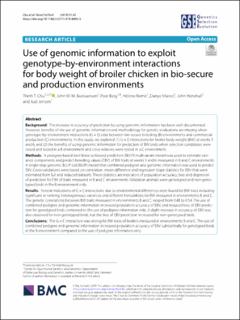| dc.contributor.author | Chu, Thinh Tuan | |
| dc.contributor.author | Bastiaansen, John WM | |
| dc.contributor.author | Berg, Peer | |
| dc.contributor.author | Rome, Helene | |
| dc.contributor.author | Marois, Danye | |
| dc.contributor.author | Henshall, John | |
| dc.contributor.author | Jensen, Just | |
| dc.date.accessioned | 2020-11-09T15:08:29Z | |
| dc.date.available | 2020-11-09T15:08:29Z | |
| dc.date.created | 2019-11-17T16:29:13Z | |
| dc.date.issued | 2019 | |
| dc.identifier.issn | 0999-193X | |
| dc.identifier.uri | https://hdl.handle.net/11250/2686981 | |
| dc.description.abstract | Background: The increase in accuracy of prediction by using genomic information has been well-documented. However, benefits of the use of genomic information and methodology for genetic evaluations are missing when genotype-by-environment interactions (G × E) exist between bio-secure breeding (B) environments and commercial production (C) environments. In this study, we explored (1) G × E interactions for broiler body weight (BW) at weeks 5 and 6, and (2) the benefits of using genomic information for prediction of BW traits when selection candidates were raised and tested in a B environment and close relatives were tested in a C environment. Methods: A pedigree-based best linear unbiased prediction (BLUP) multivariate model was used to estimate variance components and predict breeding values (EBV) of BW traits at weeks 5 and 6 measured in B and C environments. A single-step genomic BLUP (ssGBLUP) model that combined pedigree and genomic information was used to predict EBV. Cross-validations were based on correlation, mean difference and regression slope statistics for EBV that were estimated from full and reduced datasets. These statistics are indicators of population accuracy, bias and dispersion of prediction for EBV of traits measured in B and C environments. Validation animals were genotyped and non-genotyped birds in the B environment only. Results: Several indications of G × E interactions due to environmental differences were found for BW traits including significant re-ranking, heterogeneous variances and different heritabilities for BW measured in environments B and C. The genetic correlations between BW traits measured in environments B and C ranged from 0.48 to 0.54. The use of combined pedigree and genomic information increased population accuracy of EBV, and reduced bias of EBV prediction for genotyped birds compared to the use of pedigree information only. A slight increase in accuracy of EBV was also observed for non-genotyped birds, but the bias of EBV prediction increased for non-genotyped birds. Conclusions: The G × E interaction was strong for BW traits of broilers measured in environments B and C. The use of combined pedigree and genomic information increased population accuracy of EBV substantially for genotyped birds in the B environment compared to the use of pedigree information only. | en_US |
| dc.language.iso | eng | en_US |
| dc.rights | Navngivelse 4.0 Internasjonal | * |
| dc.rights.uri | http://creativecommons.org/licenses/by/4.0/deed.no | * |
| dc.title | Use of genomic information to exploit genotype-by-environment interactions for body weight of broiler chicken in bio-secure and production environments | en_US |
| dc.type | Peer reviewed | en_US |
| dc.type | Journal article | en_US |
| dc.description.version | publishedVersion | en_US |
| dc.source.volume | 51 | en_US |
| dc.source.journal | Genetics Selection Evolution | en_US |
| dc.source.issue | 1 | en_US |
| dc.identifier.doi | 10.1186/s12711-019-0493-3 | |
| dc.identifier.cristin | 1748411 | |
| cristin.unitcode | 192,10,1,0 | |
| cristin.unitname | Institutt for husdyr- og akvakulturvitenskap | |
| cristin.ispublished | true | |
| cristin.fulltext | original | |
| cristin.qualitycode | 2 | |

